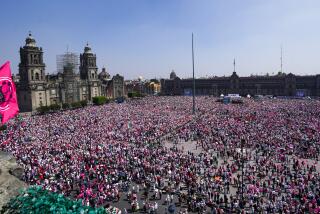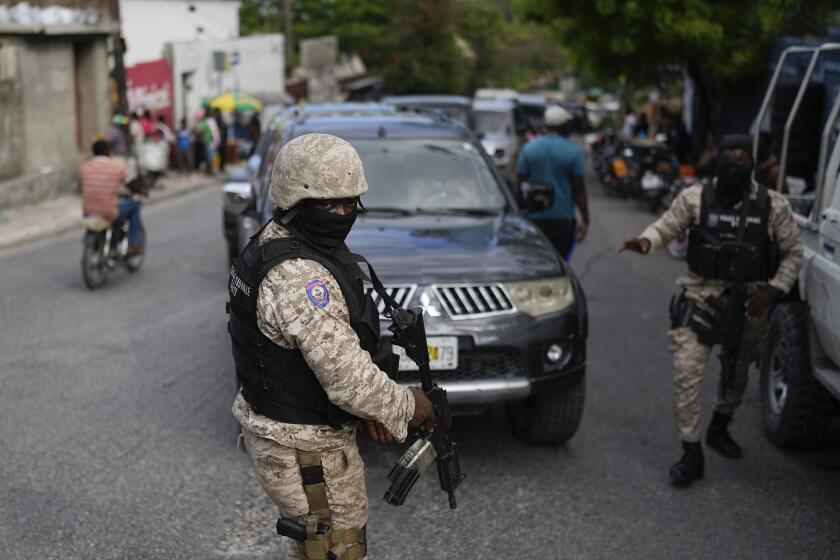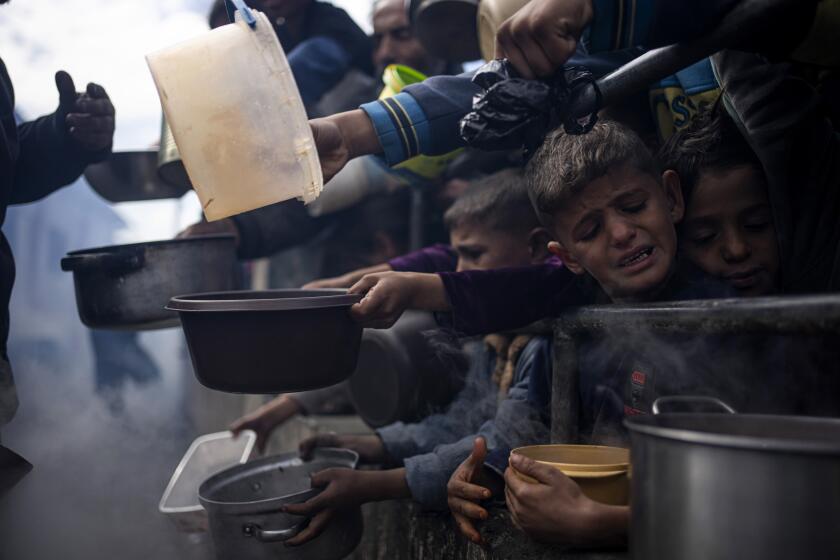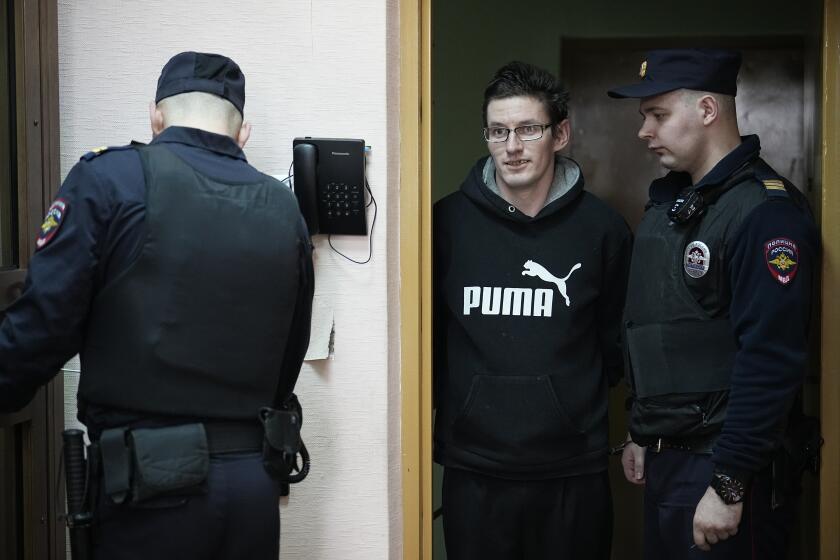The fall and rise of Mexico’s PRI
MEXICO CITY — When Mexico’s long-ruling party was ousted by voters 12 years ago, giddy celebrants hailed the event as something like the fall of the Berlin Wall.
For seven decades, the Institutional Revolutionary Party, or PRI, had governed virtually unchallenged, aided by election trickery, a well-honed ability to buy off potential troublemakers and, when that didn’t work, an iron fist. Its historic loss in 2000, and its tumble to third place six years later, led some to even imagine a Mexico without the PRI.
Now the PRI is on the verge of an epic comeback. Polls show the party’s presidential candidate, Enrique Peña Nieto, holding a double-digit lead over three rivals ahead of the July 1 vote. The party could also end up with majorities in both houses of Congress for the first time in 15 years.
The PRI’s march back from humiliation owes as much to widespread anger over skyrocketing drug violence and an anemic job market as to any lessons learned.
But the possibility of a PRI triumph raises a question now at the heart of the race: What kind of PRI would govern — a cleaned-up, “new PRI” retooled for a modernizing Mexico, or the opaque monolith of yore, with its dark intrigues, rampant graft and authoritarian streak?
Mindful that many Mexicans have bad memories of the party’s reign, Peña Nieto has sought to assure voters that he has no plans to “reinstate the past.”
“Mexico has changed politically, and without doubt today we have a democratic regime that is much more solid and strengthened,” Peña Nieto told a group of foreign correspondents during a rare news conference recently. “It is exactly my party that may be the best prepared for democratic competition.”
Opponent Josefina Vazquez Mota of the ruling conservative National Action Party, or PAN, directed comments during a televised debate to Mexican voters too young to remember the PRI era.
“Ask your parents,” she said.
Many critics view handing the country back to the PRI as akin to letting an abusive spouse return, saying it could endanger the steps Mexico has taken toward democracy. They cite scandals surrounding several former and current PRI governors, including the discovery of suitcases of money and allegations of ties to drug cartels, as evidence that the bad old days aren’t so old after all.
“The corruption is going to come back. The abuses are going to come back,” said Alfredo Sanchez, a 42-year-old commercial manager who said he still hadn’t decided which other candidate to support. “It’s changed some things, but its essence hasn’t changed.”
Sanchez was among several thousand people taking part in a recent demonstration against Peña Nieto in downtown Mexico City. The PRI was equally a target. Amid chants and fireworks, marchers carried posters bearing the face of former President Carlos Salinas de Gortari, of the PRI, grafted to a rat’s body.
Salinas, whose six-year term ended in 1994, remains for many Mexicans an emblem of shadowy dealings and mismanagement under the PRI.
The party, born in 1929 after a decade of post-revolutionary turmoil, maintained stability for decades through a vast political machine that pervaded Mexican life, using patronage and sweetheart deals to tame unions, bureaucrats, peasant groups and intellectuals, while keeping the media and dissidents largely muzzled through coercion or force.
It was often difficult to tell where the party stopped and government began. Around election time, operatives would show up in impoverished communities toting bags of cement or installing power lines in a familiar ritual of vote-buying. In case that wasn’t enough, PRI hacks paid residents for their votes or simply stuffed ballot boxes.
Mexican writer and Nobel laureate Octavio Paz dubbed the PRI a “philanthropic ogre.” Peruvian writer Mario Vargas Llosa called it “the perfect dictatorship.”
“It was a very ingenious — some might even have called it genial — system,” said historian and commentator Enrique Krauze, who was part of a student movement in the late 1960s and early 1970s that was violently put down by Mexican security forces. “But for me, the main thing is that it was not democratic.”
All the talk of a return of the PRI obscures a basic truth: It has never really left. Though booted from the president’s mansion, it still governs more than half of Mexico’s 2,440 cities and towns, and 20 of 31 states, owing to steady gains at the polls since 2009.
“It lost the presidency … but it didn’t lose everything,” said Rosa Maria Miron, a political science professor at the National Autonomous University of Mexico. “It’s important to remember that the PRI was not totally defeated.”
The PRI’s long-standing nationwide reach gives it a presence in even the tiniest Mexican village, much like Coca-Cola and a brand of Mexican bread known as Bimbo, providing the foundation for its 12-year rebuilding project.
In recent years, PRI leaders have sought to shore up grass-roots party committees through block-by-block, shoe-leather organizing. They’ve recruited candidates from the places they’d be running, rather than importing them from other states, and taken pains to avoid the kind of internal split that in 2006 spelled disaster for the party’s presidential candidate, Roberto Madrazo.
Time-honored recruiting techniques remain a staple: In the northern state of Coahuila, PRI leaders boosted its ranks with the help of a card offering pharmacy discounts to elderly members.
Peña Nieto, who until last year governed the central state of Mexico, the most populous in the country, emerged after the calamitous 2006 election as the PRI’s best chance at rescue. He steadily built a following by dispatching campaign workers to help PRI candidates in far-off places, or going himself.
Peña Nieto is also credited with canny horse-trading aimed at preventing damaging rifts. In the end, no candidate challenged him for the PRI nomination.
“The PRI of 2012 is not the PRI of the 20th century. It’s a better-organized PRI that learned the lessons of political orphanhood,” said Cesar Camacho, president of a party-sponsored think tank called the Colosio Foundation.
Party activists and some analysts insist that Mexico — and the chameleon-like PRI — have changed too much for a return to the top-down, all-pervasive style that allowed the party to rule for so long with little genuine opposition.
Reforms during the last 20 years, some begun under the PRI, spell cleaner elections and more transparent government. Mexico’s Congress, once a rubber-stamp assembly, is now a force in its own right, while clout has also shifted to state governors, weakening any president’s ability to rule by edict. And since 2000, competing political parties have learned how to win.
“It can’t be the same old PRI because it’s another Mexico, another country,” said Miron, the political scientist.
Doubters say the party might be slicker, but it carries DNA that makes it as authoritarian and Machiavellian as ever. Some saw its thuggish side at work when videos aired recently showing assailants going after Peña Nieto critics at rallies in two different states.
Krauze, the historian, said old-guard PRI politicians, known colloquially as “dinosaurs,” might be tempted to turn the clocks back if the party wins next month. But a spunkier media and stronger watchdog groups would make that difficult, he said.
“If they win, they will have to show us — every day, every minute — that they are only a party working within the framework of democracy,” Krauze said. Peña Nieto “will have a truly difficult time to act as if nothing had happened … and that the good old days are here again.”
More to Read
Start your day right
Sign up for Essential California for news, features and recommendations from the L.A. Times and beyond in your inbox six days a week.
You may occasionally receive promotional content from the Los Angeles Times.







